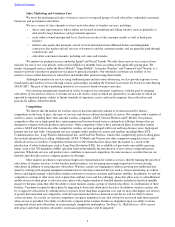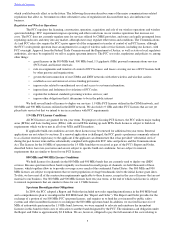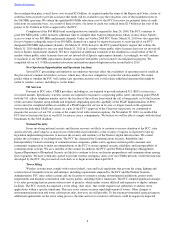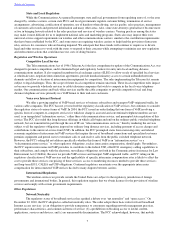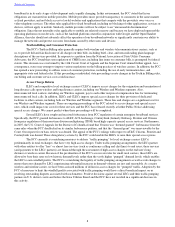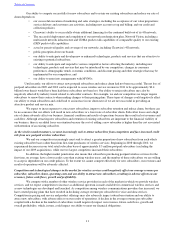Sprint - Nextel 2010 Annual Report Download - page 15
Download and view the complete annual report
Please find page 15 of the 2010 Sprint - Nextel annual report below. You can navigate through the pages in the report by either clicking on the pages listed below, or by using the keyword search tool below to find specific information within the annual report.
prospects.
Our wireless networks provide services utilizing CDMA and iDEN technologies. Wireless subscribers served by
these two technologies represent a smaller portion of global wireless subscribers than the subscribers served by wireless
networks that utilize Global System for Mobile Communications (GSM) technology. As a result, our costs with respect to both
CDMA and iDEN network equipment and devices may continue to be higher than the comparable costs incurred by our
competitors who use GSM technology, which places us at a competitive disadvantage.
We have expended significant resources and made substantial investments to deploy a 4G mobile broadband network
through Clearwire using WiMAX technology. WiMAX may not perform as we expect, and, therefore, we may not be able to
deliver the quality or types of services we expect. Other competing technologies, including other 4G or subsequent
technologies such as LTE, that may have advantages over WiMAX are being developed, and operators of other networks based
on those competing technologies may be able to deploy these alternative technologies at a lower cost and more quickly than the
cost and speed with which Clearwire deploys its 4G network providing 4G MVNO services to Sprint, which may allow those
operators to compete more effectively or may require us and Clearwire to deploy such technologies. These risks could reduce
our subscriber growth, increase our costs of providing services or increase our churn.
We entered into agreements in 2008 with Clearwire to integrate our former 4G wireless broadband business with
theirs. See “Risks Related to our Investment in Clearwire” below for additional risks related to our investment in Clearwire and
the deployment of 4G.
Current economic conditions, our recent financial performance and our debt ratings could negatively impact our access to
the capital markets resulting in less growth than planned or failure to satisfy financial covenants under our existing debt
agreements. Moreover, Clearwire may be considered a subsidiary under certain agreements relating to our indebtedness.
Although we do not believe we will require additional capital to make the capital and operating expenditures
necessary to implement our business plans or to satisfy our debt service requirements for the next few years, we may need to
incur additional debt in the future for a variety of reasons, including future investments or acquisitions. Our ability to arrange
additional financing will depend on, among other factors, our financial performance, debt ratings, general economic conditions
and prevailing market conditions. Some of these factors are beyond our control, and we may not be able to arrange additional
financing on terms acceptable to us, or at all. Failure to obtain suitable financing when needed could, among other things, result
in our inability to continue to expand our businesses and meet competitive challenges. Our debt ratings could be downgraded if
we incur significant additional indebtedness, or if we do not generate sufficient cash from our operations, which would likely
increase our future borrowing costs and could affect our ability to access capital.
Our credit facility, which expires in October 2013, requires that we maintain a ratio of total indebtedness to trailing
four quarters earnings before interest, taxes, depreciation and amortization and other non-cash gains or losses, such as goodwill
impairment charges, of no more than 4.5 to 1.0. The ratio will be reduced to 4.25 to 1.0 beginning in April 2012, and further
reduced to 4.0 to 1.0 in January 2013. As of December 31, 2010, the ratio was 3.7 to 1.0. If we do not continue to satisfy this
ratio, we will be in default under our credit facility, which could trigger defaults under our other debt obligations, which in turn
could result in the maturities of certain debt obligations being accelerated. Certain indentures governing our notes limit, among
other things, our ability to incur additional debt, pay dividends, create liens and sell, transfer, lease or dispose of assets.
As of December 31, 2010, we own a 54% economic interest in Clearwire. As a result, Clearwire could be considered
a subsidiary under certain agreements relating to our indebtedness. Whether Clearwire could be considered a subsidiary under
our debt agreements is subject to interpretation. In December 2010, as a result of an amendment to the Clearwire equityholders'
agreement, Sprint obtained the right to unilaterally surrender voting securities to reduce its voting security percentage below
50%, which could eliminate the potential for Clearwire to be considered a subsidiary of Sprint. Until Sprint exercises this right,
certain actions or defaults by Clearwire would, if viewed as a subsidiary, result in a breach of covenants, including potential
cross-default provisions, under certain agreements relating to our indebtedness.
The trading price of our common stock has been and may continue to be volatile and may not reflect our actual operations
and performance.
Market and industry factors may seriously harm the market price of our common stock, regardless of our actual
operations and performance. Stock price volatility and sustained decreases in our share price could subject our shareholders to
losses and us to takeover bids or lead to action by the NYSE. The trading price of our common stock has been, and may
continue to be, subject to fluctuations in price in response to various factors, some of which are beyond our control, including,
but not limited to:
• quarterly announcements and variations in our results of operations or those of our competitors, either alone or
in comparison to analysts expectations, including announcements of subscriber counts and rates of churn that
would result in downward pressure on our stock price;
• the availability or perceived availability of additional capital and market perceptions relating to our access to
this capital;
Table of Contents
13


